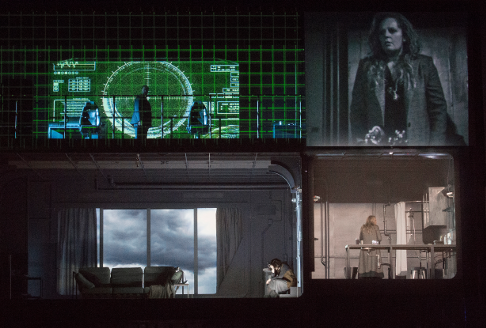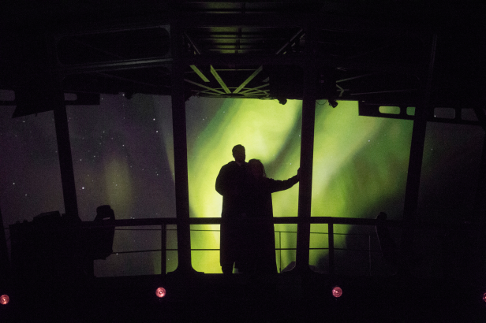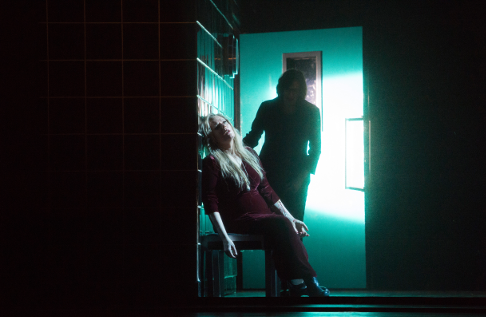23 Apr 2016
Simon Rattle conducts Tristan und Isolde
New Co-Production Tristan und Isolde with Metropolitan: Simon Rattle and Westbroek electrify Treliński’s Opera-Noir.

New Co-Production Tristan und Isolde with Metropolitan: Simon Rattle and Westbroek electrify Treliński’s Opera-Noir.
In a letter to Mathilde Wesendonck, Richard Wagner writes about Tristan und Isolde: “I would call my art....the art of transformation. The masterful point in this work is certainly the great scene of the second act”. This sums up Mariusz Treliński’s technically mind blowing Tristan und Isolde. The stage in the first act transforms through highly complex engineering, while the second act was one of the most dazzling, Romantic opera settings I have witnessed. With Simon Rattle at the helm of his Berliner Philharmoniker, the performance resulted in a superlatively transformative experience; however much exhausting in Act III, you would not want to miss it for the world. And with the Herculean Eva-Maria Westbroek as Isolde, the performance in Baden-Baden became an unforgettable memory.

Video projections of a ship at sea during a storm complemented the Prelude in its metaphor for Tristan and Isolde’s tempestuous emotions. At the same time, that ship could have been Captain Rattle’s Berliner. From the opening, the BPO played with astounding intensity. I immediately realised I was in for a very privileged journey.
As Maestro Rattle unfolded Wagner’s luscious tapestry, he ceaselessly generated a resounding depth from his strings. Wagner’s swooning romance and erotic tension overflowed in full force. Dense in texture the leitmotifs resonated deeply. Sir Simon sustains such captivating suspense without interruption that as a listener it was impossible not to feel included in his musical universe. And one cannot forget the men of the Philharmonia Chorus Vienna, who from the pit jolted the piece with their generous energy. In addition, the Festspielhaus greatly amplified the level of musical detail and intensity with its transparent and enveloping acoustics.

As the first act opens, we see a highly complex staging of a military naval vessel. Dark metallic colours dominate. What little light there is, reflects into the audience. The set by Boris Kudlička and Marc Heinz’s lighting impressed as through complex engineering the stage switched its focus: covering three floors, the deck, the stairwell, the Captain’s quarter’s below, and Isolde’s room at the centre.
The stage functioned like a comic book panel that was each time covered and lit from different angles. Through spy footage, Bartek Macias’s videos of Isolde from different angles projected her on the ever changing stage. Although it sounds like too much, this might be true in the end, but for now the energetic dynamics on stage enthralled.
From the bat Ms. Westbroek dazzled dominating the stage: her voice full of violent distrust, as Treliński makes his Isolde a femme fatale before she has fallen in love. The Dutch Diva convinced both in that capacity, as well later as the enamored Isolde later, when her vibrato conquered all.

In Act I, dressed in black, she smokes, drinks, and even slaps Melot, played deviously by Roman Sadnik. Sarah Connolly transformed for Braegene into a persuasive secretary (spectacles and all) highly involved, with a dark but affectionate tone that contrasted Ms. Westbroek in the best of ways. Together they created a sound to behold.
The second act was one of the most memorable opera moments I have had. On stage we see the ship‘s wheelhouse that throughout rotates as the action takes place, eventually establishing the setting for the love duet. But for the Northern Lights morphing around behind the two lovers, all is darkness. The flux of those green lights certainly symbolized the transformative nature of this experience and gave this production a feeling cosmic grandeur.
As Tristan and Isolde breathed in darkness with the Northern Lights in the background, the Berliner’s music gained the foreground and Skelton and Westbroek launched into a captivating “O sink hernieder, Nacht der Liebe”. While Mr Skelton never reached the voluminous vocal heights of Ms. Westbroek, he compensated with authentic sensitivity, including even some glass eyed moments. I imagine Wagner would have loved to witness such indulgent and thoughtfully atmospheric moods for his Gesamtkunstwerk.
Each excessively budgeted production reaches a tipping point. At some point it all becomes too much to absorb. Here it occurred in the final act, when everything turns strangely static. The glaring metallic reflections tortured the audience’s vista; as if trying to keep you awake, but with agitating results.
A sullen ambience emerged and a lone hospital bed made for Kurnewal and Tristan’s interaction. As a brotherly Kurnewal, Michael Nagy commanded the stage, even vocally upstaging Mr. Skelton. Still no matter the musical excellence, a nagging dread permeated the first part of the third act.
With the memory of young Tristan in a broken down home in a projection of a forest, Treliński’s applied psychology felt unnecessary and the video excessively taxed the experience of the third act. Perhaps he wanted to slow down the momentum before Isolde’s Liebestod, but the pause in momentum made it quickly clear how consuming the first two acts had already been.
When she returned, Eva-Maria impressively reignited the musical momentum. For “Das Wiedersehen” she stormed onto the stage creating such an impetus with her electrifying voice. Even more impressively, she brought back the preceding intoxication. Her “Liebestod” closed the evening with such persuasive power, leaving me exhausted, drained, but profoundly changed by the overall experience.
The audience responded with a mighty applause and bravas for Ms Westbroek and Sir Simon, while expected boos met Treliński and his team (this is Tristan und Isolde after all). The staging ended up a bit too extravagant with all its excessive sensory stimulation, but the rendition was superlative in its musical execution. This co-production with Shanghai and Warsaw opera houses, opens the Met’s new season in September...also with Simon Rattle at the helm.
David Pinedo
Cast and production information:
Eva-Maria Westbroek (Isolde); Stuart Skelton (Tristan); Sarah Connolly (Brangäne); Michael Nagy Bass (Kurwenal); Stephen Milling (König Marke); Thomas Ebenstein (Shepherd, Sailor); Roman Sadnik (Melot); Simon Stricker (Steersman). Rundfunkchor Berlin, Simon Halsey (Chorus Master). Berliner Philharmoniker, Sir Simon Rattle (Conductor).